Back to > Major Fruits | Minor Fruits | Underutilized Fruits
![]()
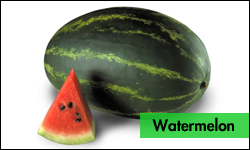 |
||
|
|
||
Distribution and Cultivars:
Crop History:
Watermelons originated in the deserts and semi-tropical regions of Africa. Egyptians have been cultivating the melons for more than 4,000 years. The fruit served as an important source of water in the desert. African slaves and Christian missionaries introduced the watermelon to the rest of the world. Evidence of watermelon cultivation in Ancient Egypt was recorded in hieroglyphics painted on building walls dated back to 2500 BC. However, its first cultivation in the Nile Valley began at least as early as the second millennium BC. The fruit was held in such regard that it was placed in the tombs of many Egyptian kings. Numerous watermelon seeds were recovered from the tomb of Pharaoh Tutankhamun (Daniel Zohary and Maria Hopf, 2000). It is not surprising that watermelon played such an important role in this country, and subsequently in countries in the Mediterranean region, since water was often in short supply in these areas, and people could depend upon watermelon for its thirst-quenching properties.
David Livingston found wild watermelons in the Kalahari Desert in 1850s. Watermelon was brought to the New World by the African slaves and European colonialists. It was brought to Brazil and then to the West Indies, north eastern America, the islands of the Pacific, and to New Zealand and Australia. The watermelon arrived in the Americas in the early 1600s with traders and was first cultivated in Massachusetts in 1629. Museums Online South Africa lists watermelons as having been introduced to North American Indians in the 1500s. Early French explorers found Native Americans cultivating the fruit in the Mississippi Valley. Many sources list the watermelon as being introduced in Massachusetts as early as 1629. Parsons also mentions the crop being farmed by Native Americans in Florida (by 1664) and the Colorado River area (by 1799). Other early watermelon sightings include the Midwestern states (1673), Connecticut (1747), and the Illiana region (1822).
By the middle of the 17th century, watermelon had made its way down to Florida.
By the 10th century AD, watermelons were being cultivated in China, which is today the world’s single largest watermelon producer. By the 13th century, Moorish invaders had introduced the fruit to Europe. In Vietnam, legend holds that watermelon was discovered in Vietnam long before it reached China, in the era of the Hùng Kings. According to legend, watermelon was discovered by Prince Mai An Tiêm, an adopted son of the 11th Hùng King. When he was exiled unjustly to an island, he was told that if he could survive for six months, he would be allowed to return. When he prayed for guidance, a bird flew past and dropped a seed. He cultivated the seed and called its fruit “dưa tây” or western melon, because the birds ate it while flying from the west. When the Chinese took over Vietnam in about 110 BC, they called the melons “dưa hảo” (good melon) or “dưa hấu”, “dưa Tây”, “dưa hảo”, “dưa hấu”—all words for “watermelon”. Tiêm’s island is now a peninsula in the suburban district of Nga Sơn. Watermelon is probably introduced into Peninsular Malaysia by the early Indian and Chinese merchants in the 14th century (Salleh 1986).
Importance and Value
Watermelon is grown in over 96 countries worldwide and there are 1.3 million hectares. In Russia, where much of the commercial supply of watermelons is grown, there is a popular wine made from this fruit. In addition to Russia, the leading commercial growers of watermelon include China, Turkey, Iran and the United States. China ranks first in worldwide watermelon production (57.531 million tonnes in 2002) and the United States currently ranks fourth (1.778 million tonnes in 2002). In China and Japan watermelon is a popular gift to bring a host. Watermelon is 92% water. Watermelon is avaialble in the traditional red variety, as well as the lesser known yellow variety.
Crop Usage
Most of the U.S. watermelon production is consumed fresh. US per capita watermelon consumption in 2003 was 6.2 kg and watermelon is about 1/3 more popular in the Western states then in the Midwest and East. About 85% of watermelons are purchased at the retail level for home consumption. Other processed products include roasted seeds, pickled rind and watermelon juice.
Today, farmers in the U.S. grow watermelon commercially, and almost all these varieties have some Charleston Gray (the fruit is oblong shape and hard rind made it easy to stack and ship). Its adaptability meant it could be grown over a wide geographical area. It produced high yields and was resistant to the most serious watermelon diseases: anthracnose and fusarium wilt in their lineage. This now-common watermelon is often large enough that groceries often sell half or quarter melons. There are also some smaller, spherical varieties of watermelon, both red- and yellow-fleshed, sometimes called “icebox melons.”
In Japan, farmers of the Zentsuji region found a way to grow cubic watermelons, by growing the fruits in glass boxes and letting them naturally assume the shape of the receptacle. The square shape is designed to make the melons easier to stack and store, but the square watermelons are often more than double the price of normal ones. Pyramid shaped watermelons have also been developed.
For commercial plantings, one beehive per 9,000 m² is the minimum recommendation by the USDA for pollination of conventional, seeded varieties. Because seedless hybrids have sterile pollen, pollinator rows of varieties with viable pollen must also be planted. Since the supply of viable pollen is reduced and pollination is much more critical in producing the seedless variety, the recommended number of hives per hectare, or pollinator density is one hive per 1,300 m².
Although so-called “seedless” watermelons have far fewer seeds than the seeded varieties, they generally contain at least a few soft, pale seeds. They are the product of crossing a female tetraploid plant (itself the product of genetic manipulation, using colchicines) with diploid pollen. The resulting triploid plant is sterile, but will produce the seedless fruit if pollinated by a diploid plant. For this reason, commercially available seedless watermelon seeds actually contain two varieties of seeds; that of the triploid seedless plant itself (recognizable because the seed is larger), and the diploid plant which is needed to pollinate the triploid. Unless both plant types are grown in the same vicinity, no seedless fruit will result.
Watermelons (Citrullus lunatus) are in the family Cucurbitaceae and there is a large range of varieties available for planting. They vary in shape, size and internal and external color. There are over 1,200 varieties of watermelon worldwide available for planting. Watermelons are grouped according to fruit size, flesh color, and with or without seeds.
The most sought after standard types are those with dark striped skin with rich red flesh and very black seeds. Mini melons are popular on the market and are sold in cartons. Seedless melons have become an important crop. They vary in shape, size and internal and external color. The most sought after standard types are those with dark striped skin with rich red flesh and very black seeds. Mini melons are popular on the market and are sold in cartons. Seedless melons have become an important crop.
Watermelons were considered a seasonal fruit, but today imports combined with local production ensure a year-round supply. Meanwhile, “Icebox” watermelons are gaining in popularity as they are ideal for small families and fit easily into a refrigerator.
Several notable Western and Australian varieties are included here:
- Large Australian watermelons – Red Tiger, Bengal Tiger, Phantom, Pharoah, Red Dragon, Genghis, Hercules and many more)
- Mini Australian melons – Gemini, Minilee (O.P.), Baby lee, Baby Tiger, Sugar Baby
- Popular seedless (triploid) Australian varieties – Honeyheart (yellow), Raven (red), Dragon Heart (red), Triple Heart (red), Banquet (red), Golden acre (yellow) and Seedless 1600) .
Hybrid Blackita F1 – maturity (84 days), fruit weight (7 kg), brix (11.5°), flesh color (deep red), seed size & color (medium, mottled brown), resistance to transport, disease resistance/tolerance
- (Fusarium). Terrific internal color, firm flesh, and very attractive external green color make this hybrid a qualifier for the markets that accept this type.
- Hybrid Marita F1– maturity (83 days), fruit weight (6-7 kg), brix (12°), flesh color (deep red), seed size & color (medium, mottled brown), resistance to transport, disease resistance/tolerance (Fusarium). A round, medium green, dark striped watermelon, with terrific internal color and firmness suitable for fresh market and for processing.
- Hybrid Early Mara F1 – maturity (82 days), fruit weight (10-11 kg), brix (12°), flesh color extra (deep red), seed size & color (small, black), resistance to transport, disease resistance/tolerance (Fusarium) & Anthracnose comments. Early Mara has the same external look, large dark stripes, and the best internal color and firmeness.
- Hybrid Florida Sweet F1 – maturity (85 days), fruit weight (9-10 kg), brix (12°), flesh color (deep red), seed size & color (small, black), resistance to transport, disease resistance/tolerance (Fusarium & Anthracnose). A medium size diploid, with very high internal quality, as a pollinator as well as a Calsweet type hybrid, for diploid production.
- Hybrid Royal Peacock F1 – maturity (86 days), fruit weight (11-12 kg), brix (11°), flesh color (deep red), seed size & color (small, black), resistance to transport, disease resistance/tolerance (Fusarium & Anthracnose). It has a very long shelf life and a fantastic internal color, with a very durable flesh that supports rough transportation.
- Hybrid Samanta F1 – maturity (85 days), fruit weight (10-12 kg), brix (12°), flesh color (deep red), seed size & color (small, black), resistance to transport, disease resistance/tolerance (Fusarium & Anthracnose). Elongated shape, exceptional interior quality, combined with a very attractive, dark striped external look. Super productive!
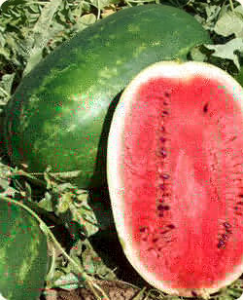 |
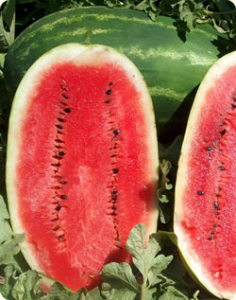 |
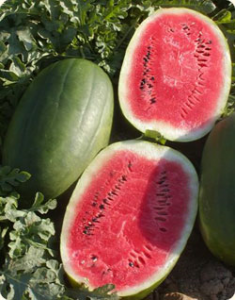 |
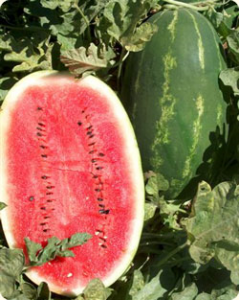 |
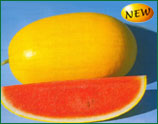 |
- Diana (F1 Hybrid). The attractions of this variety are its beautiful golden-yellow rind and the uniform oblong shape. The vigorous plant is early and productive, with a strong fruit-setting. Fresh is red, tender and juicy, with 12% sugar content. The rind is thin but good for shipping and storage. Approximately 2.5kg in weight.
- Carolina Cross: This variety of watermelon produced the current world record watermelon weighing 119 kg. It has green skin, red flesh and commonly produces fruit between 29 and 68 kg. It takes about 90 days from planting to harvest.
- Yellow Crimson Watermelon: variety of watermelon that has a yellow colored flesh. This particular type of watermelon has been described as “sweeter” and more “honey” flavored than the more popular red flesh watermelon.
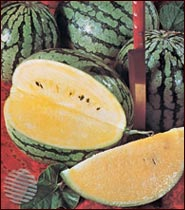 |
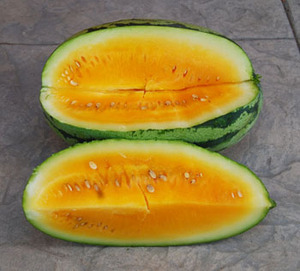 |
- Orangeglo: This variety has a very sweet orange pulp, and is a large oblong fruit weighing 9–14 kg. It has a light green rind with jagged dark green stripes. It takes about 90-100 days from planting to harvest.
- The Moon and Stars variety of watermelon has been around since 1926. The rind is purple/black and has many small yellow circles (stars) and one or two large yellow circles (moon). The melon weighs 9–23 kg. The flesh is pink or red and has brown seeds. The foliage is also spotted. The time from planting to harvest is about 90 days.
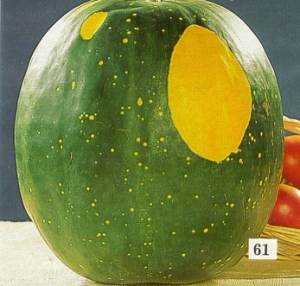 |
 |
- Cream of Saskatchewan: This variety consists of small round fruits, around 25 cm in diameter. It has a quite thin, light green with dark green striped rind, with sweet white flesh and black seeds. It can grow well in cool climates. It was originally brought to Saskatchewan, Canada by Russian immigrants. These melons take 80–85 days from planting to harvest.
- Melitopolski: This variety has small round fruits roughly 28-30 cm in diameter. It is an early ripening variety that originated from the Volga River region of Russia, an area known for cultivation of watermelons. The Melitopolski watermelons are seen piled high by vendors in Moscow in summer. This variety takes around 95 days from planting to harvest.
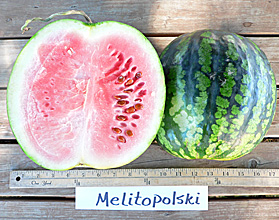 |
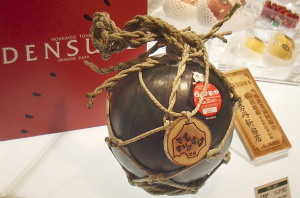 |
- Densuke Watermelon: This variety has round fruit up to 11 kg. The rind is black with no stripes or spots. It is only grown on the island of Hokkaido, Japan where up to 10 000 watermelons are produced every year. In June 2008, one of the first harvested watermelons was sold at an auction for 650 000 yen (6300 USD), making the most expensive watermelon ever sold. The average selling price is generally around 25 000 yen (250 USD).
- Extazy is a “seedless“ mini watermelon hybrid, with striped skin, Crimson Sweet type.The fruit has a perfectly spherical shape and reaches a medium size of 2.5 kg. The deep red pulp, thanks to the presence of the lycopene (a carotenoid acting as an antioxidant in the prevention of particular carcinomas and pathologies of the cardiovascular system) is very sweet, crispy and tasty. The fruit wall thickness (1.5 cm) allows their easy and quiet heaping, with no danger of cracking or deteriorations of the pulp. The post harvesting storage, owing to the lack of seeds, is very long. We suggest high plant densities. Cycle: 80-85 days from transplanting. Fruit: oval shape, medium weight 2-3kg, dark green skin with light stripes, deep red pulp, and excellent shelf life.
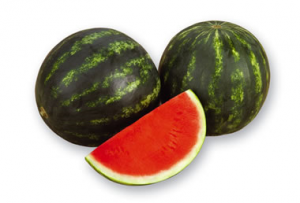 |
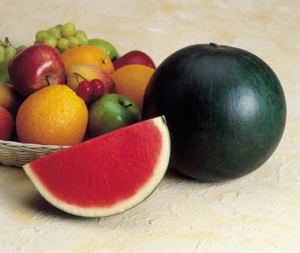 |
- Liliput is a “Sugar Baby” type, mini watermelon hybrid, characterized by the presence of very few seeds. The fruit with a perfectly spherical shape, reaches the medium weight of 2.5 kg. The pulp, crispy and tasty, thanks to the very high brix degree, has a deep red color. The fruit walls are thick (1.5 cm), thus allowing an easy and quiet heaping of fruits with no danger of cracking or deteriorations of the pulp. Besides, the uniformity of fruit ripening is excellent and they show a very long post harvesting storage. Cycle: 80-85 days from transplanting. Fruit: oval shape, medium weight kg 2.5, dark skin, deep red pulp and excellent shelf life. Kind of growing: protected crop or open air. Unit investment: 20,000 plants/ha
- Eve is an excellent hybrid of “seedless” mini watermelon, Sugar Baby type. The fruit, with a perfectly spherical shape, reaches the excellent weight of 2.5-3 kg. The pulp, deep red thanks to the higher presence of lycopene, is extremely sweet, crispy, tasty and not fibrous. This hybrid, extremely productive, shows fruits with homogeneous size, characterized by thick walls (1.5 cm), thus allowing their easy and quiet heaping with no danger of cracking or deteriorations of the pulp. Cycle: 80-85 days from transplanting. Fruit: oval shape, medium weight kg 2.5-3, dark green skin, deep red pulp and excellent shelf life. Kind of growing: protected crop or open air. Unit investment: 20,000 plants/ha. * The use of pollinator plants is required. To this purpose, we suggest to use Hazera varieties Polimore and Minipol.
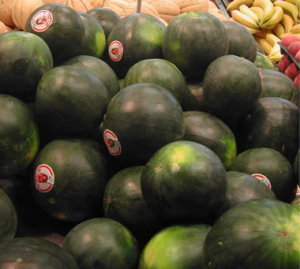 |
 |
- GOLDEN CROWN (F1 Hybrid). Golden Crown was bred for watermelon lovers and improved for earliness (about 7-80 days for sowing). Four or more fruits per plant is very common. The mature fruit is uniform, oblong, icebox-sized, weighing about 2.5kg, and with brilliant red flesh containing small seeds, Golden Crown is a delicious sweet watermelon with approximately 12% sugar content A very thin but tough rind allow good shipping.
- Pilimore is a hybrid of mini watermelon with seeds. The fruit has a round-flattened shape, a very light green skin and dark green thin stripes (Tiger type). The medium weight is equivalent to 2.5-3.5 kg. The red pulp is very crispy and tasty. The plant, very vigorous, gives an excellent production. This hybrid, extremely productive, shows fruits with homogeneous size, characterized by thick wall (1.5 cm), thus allowing their easy and quiet heaping with no danger of cracking or deteriorations of the pulp. We suggest very high plant densities. Besides, its use as a pollinator is excellent for the varieties of mini watermelons with seeds, in which case, considering the higher earliness towards the “seedless” watermelons, we suggest to carry out the sowing a week later so to get a more correct flowering overlapping . Cycle: 75-80 days from transplanting . Fruit: oval shape, medium weight kg 2.5-3.5, light green skin with dark stripes, red pulp and excellent shelf life. Kind of growing: protected crop or open air . Unit investment: 20,000 plants/ha
- Mielhart is a mini watermelon hybrid “seedless”, Tiger type. The fruit has a round-flattened shape. The medium weight is equivalent to about 2.5-3.5 kg. The pulp, deep red, is very crispy and tasty. This hybrid, extremely productive, shows fruits with a homogenous size, characterized by thick walls (1.5 cm), thus allowing their easy and quiet heaping with no ranger of cracking or deteriorations of the pulp. The plant, very vigorous, gives an excellent production. We suggest very high plant densities. Cycle: 80-85 days from transplanting. Fruit: oval shape, medium weight 2.5-3.5 kg, light green skin with dark stripes , deep red pulp and excellent shelf life. Kind of growing: protected crop or open air. Unit investment: 20.000 plants /ha
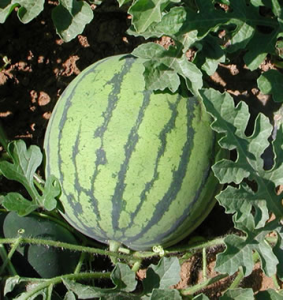 |
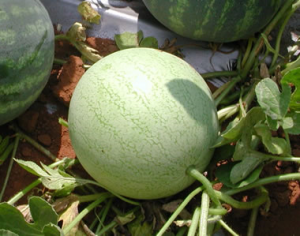 |
- Minipol is a mini watermelon hybrid with seeds, it shows a light green skin and it has a very tasty pulp. It has come out to be ideal as a pollinator for the mini watermelons Hazera, particularly for the variety Mielhart since it allows, during the harvesting stage, the easy fruit distinction. Considering the higher earliness compared to “seedless” watermelons, we suggest to carry out the sowing a week later so to get a more correct flowering overlapping. **The use of pollinator plants is required. To this purpose, we suggest to use the variety from Hazera Minipol.
- Sugar Baby is a delicious super sweet, early maturing, small fruit bearing “icebox watermelon” that was introduced in 1955. The flesh of this watermelon variety is fine textured and very sweet. The vines are also shorter than big fruited watermelon vines which are ideal for those with limited space. Developed with the home gardener in mind. An open pollinated Ice Box Midget watermelon variety with sweet red flesh and a smooth, round dark green shape. Produces watermelons up to 9 pounds in weight with an 8 inch diameter. 70 to 75 days to maturity.
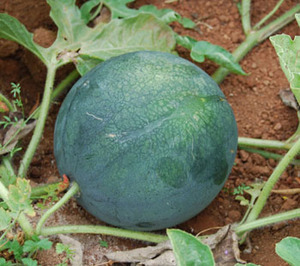 |
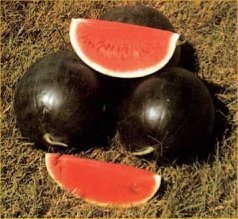 |
- New Dragon (F1 Hybrid)- New Dragon watermelon has gained wide acceptance around the world due to its good resistance to CMV. It matures early and is also widely adapted to various types of soil. Fruit is oblong, quite uniform, and about 9kg in weight. Flesh is sharp red, finely textured and very sweet.
- Green Mountain (F1 Hybrid). Widely adapted to various types of soil and resistance to sunburn. Fruit is oblong, weighing around 10kg. Rind is light green with blushing-black stripes. Flesh is scarlet-red, with high sugar content, and juicy with fine texture.
- China Baby (F1 Hybrid). This improved sister cultivar of Empire No. 2 has better quality and more stability. The plants are moderately vigorous. This large oblong fruit weights 12-17kg and has a light green rind with netted stripes. The flesh in vivid red very sweet with about 12% sugar content, crisp, tender, and less prone to hollow heart. The brown seed are medium to small sized.
- Empire No.2 (F1 Hybrid).One of our longtime favorite varieties. It is widely adapted and much earlier that Charleston Gray. Compact short vines permit close spacing. Fruit is about 12kg with durable rind and bright red flesh. Suitable for storage and shipping. This hybrid seldom has hollow heart or misshaped fruit. Tolerant to CMV and anthracnose.
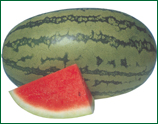 |
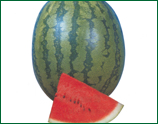 |
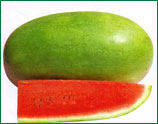 |
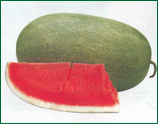 |
Reference:
- “An African Native of World Popularity.” Texas A&M University Aggie Horticulture website. Retrieved Jul. 17, 2005.
- Anioleka Seeds USA. “Yellow Crimson Watermelon”. http://www.vegetableseed.net/heirloom-vegetable-seeds/melon-seeds/watermelon-seeds/yellow.html. Retrieved on 2007-08-07.
- Baker Creek Heirloom Seeds. “Watermelon Heirloom Seeds”. http://rareseeds.com/seeds/Watermelon. Retrieved on 2008-07-15.
- Baker Creek Heirloom Seeds. “Carolina Cross Watermelon”. http://rareseeds.com/seeds/Watermelon/Carolina-Cross. Retrieved on 2008-07-15.
- (BBC) Square fruit stuns Japanese shoppers BBC News Friday, 15 June, 2001, 10:54 GMT 11:54 UK
- “Black Japanese watermelon sold at record price“. http://ap.google.com/article/ALeqM5jJBRT0pnOdQVMUzzkKC_cGHo7IdQD914F62O0. Retrieved on 2008-06-10.
- Blomberg, Marina (June 10, 2004). “In Season: Savory Summer Fruits.” The Gainesville Sun. Retrieved Jul. 17, 2005.
- “Charles Fredric Andrus: Watermelon Breeder.” Cucurbit Breeding Horticultural Science. Retrieved Jul. 17, 2005.
- Collins JK, Wu G, Perkins-Veazie P, Spears K, Claypool PL, Baker RA, Clevidence BA. (2007). Watermelon consumption increases arginine plasma concentrations in adults. Nutrition 23(3):261-6.
- “Cream of Saskatchewan Watermelon“. http://www.seedsavers.org/prodinfo.asp?number=778. Retrieved on 2007-04-23.
- “Crop Production: Icebox Watermelons.” Washington State University Vancouver Research and Extension Unit website. Retrieved Jul. 17, 2005.
- Daniel Zohary and Maria Hopf, Domestication of Plants in the Old World, third edition (Oxford: University Press, 2000), p. 193.
- Dayer, R.D. (1975). The Genera of Southern African floweringbplants Vol. 1. Dicotyledons, Department of Agricultural Technical Services. South Africa: Botanical Research Institute.
- Evans, Lynette (2005-07-15). “Moon & Stars watermelon (Citrullus lanatus):Seed-spittin’ melons makin’ a comeback”. http://sfgate.com/cgi-bin/article.cgi?file=/chronicle/archive/2005/07/16/HOG4UDNGDB1.DTL. Retrieved on 2007-07-06.
- Hamish, Robertson. “Citrullus lanatus (Watermelon, Tsamma).” Museums Online South Africa. Retrieved Mar. 15, 2005.
- H. Mandel, N. Levy, S. Izkovitch, S. H. Korman (2005). “Elevated plasma citrulline and arginine due to consumption of Citrullus vulgaris (watermelon)”. Berichte der deutschen chemischen Gesellschaft 28 (4): 467–472. doi:10.1007/s10545-005-0467-1.
- “The column of watermelon peel from 5hpk.com”.
- http://www.5hpk.com/Html/TOPIC/200807172.html. Retrieved on 2008-07-15.
- http://www.agriculture.gov.gy/Farmers%20Manual/PDF/Watermelon.pdf. Retrieved on 2009-07-30
- Jian L, Lee AH, Binns CW. Tea and lycopene protect against prostate cancer. Asia Pac J Clin Nutr. 2007;16 Suppl 1:453-7. 2007. PMID:17392149.
- Lucotti P, Setola E, Monti LD, Galluccio E, Costa S, Sandoli EP, Fermo I, Rabaiotti G,Gatti R, Piatti P. (2006). Beneficial effects of a long-term oral L-arginine treatment added to a hypocaloric diet and exercise training program in obese, insulin-resistant type 2 diabetic patients. Am J Physiol Endocrinol Metab:291(5):E906-12.
- Matos HR, Di Mascio P, Medeiros MH. Protective effect of lycopene on lipid peroxidation and oxidative DNA damage in cell culture. Arch Biochem Biophys 2000 Nov 1;383(1):56-9 2000.
- “Melitopolski Watermelon“. http://www.seedsavers.org/prodinfo.asp?number=267. Retrieved on 2007-04-23.
- “Moon and Stars Watermelon Heirloom“. http://rareseeds.com/seeds/Watermelon/Moon-and-Stars. Retrieved on 2008-07-15.
- “Moon and Stars Watermelon“. http://www.seedsavers.org/prodinfo.asp?number=266. Retrieved on 2007-04-23.
- Motes, J.E.; Damicone, John; Roberts, Warren; Duthie, Jim; Edelson, Jonathan. “Watermelon Production.” Oklahoma Cooperative Extension Service. Retrieved Jul. 17, 2005.
- Müller T, Ulrich M, Ongania KH, Kräutler B. (2007). Colorless tetrapyrrolic chlorophyll catabolites found in ripening fruit are effective antioxidants. Angew Chem Int Ed Engl. 2007;46(45):8699-702.
- National Research Council (2008-01-25). “Watermelon”. Lost Crops of Africa: Volume III: Fruits. Lost Crops of Africa. 3. National Academies Press. ISBN 978-0-309-10596-5. http://books.nap.edu/openbook.php?record_id=11879&page=165. Retrieved on 2008-07-17.
- “Oklahoma Declares Watermelon Its State Vegetable“. 2007-04-18. http://cbs4denver.com/watercooler/watercooler_story_108064706.html. Retrieved on 2007-07-20.
- “Orangeglo Watermelon“. http://www.seedsavers.org/prodinfo.asp?number=1108. Retrieved on 2007-04-23.
- Parsons, Jerry, Ph.D. (June 5, 2002). “Gardening Column: Watermelons.” Texas Cooperative Extension of the Texas A&M University System. Jul. 17, 2005.
- Salleh, H. (1986). Constrain and challenges in melon breeding in Peninsular Malaysia. Proc. Of the Plant and Animal Breeding Workshop, Serdang: MARDI
- Shosteck, Robert (1974). Flowers and Plants: An International Lexicon with Biographical Notes. Quadrangle/The New York Times Book Co.: New York.
- Southern U.S. Cuisine: Judy’s Pickled Watermelon Rind
- http://home.howstuffworks.com/watermelon3.htm
- Stone, B.C. (1970). The flora of Guam. Micronesic 6: 562.
- Vegetable Research & Extension Center – Icebox Watermelons”. http://agsyst.wsu.edu/Watermelon.html. Retrieved on 2008-08-02.
- Wada, M. (1930). “Über Citrullin, eine neue Aminosäure im Presssaft der 28. Wassermelone, Citrullus vulgaris Schrad.”. Biochem. Zeit. 224: 420.
- “Watermelon.” The George Mateljan Foundation for The World’s Healthiest Foods. Retrieved Jul. 28, 2005.
- “Watermelon History.” National Watermelon Promotion Board website. Retrieved Jul. 17, 2005.
